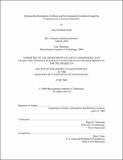Hydrocarbon biomarkers for biotic and environmental evolution through the Neoproterozoic-Cambrian transition
Author(s)
Kelly, Amy E. (Amy Elizabeth), 1980-
DownloadFull printable version (1.375Mb)
Other Contributors
Massachusetts Institute of Technology. Dept. of Earth, Atmospheric, and Planetary Sciences.
Advisor
Roger E. Summons.
Terms of use
Metadata
Show full item recordAbstract
The sequence of events over the Neoproterozoic - Cambrian transition that led to the radiation of multicellular organisms has been an issue of debate for over a century. It is a critical interval in the history of life on Earth because it marks the first appearance of all extant animal phyla in the fossil record. We set out to improve understanding of environmental transitions during this key interval of Earth's history by studying chemical fossils (biomarkers) in Neoproterozoic to Cambrian aged sedimentary rocks and oils from Australia, Eastern Siberia and Oman. This thesis presents the distributions of steranes and other hydrocarbons through these various strata and the characterization of novel age and paleostratification biomarkers. Compound specific carbon isotopic data of n-alkanes and isoprenoids were also acquired and evaluated in the context of existing datasets with a focus on elucidating the processes responsible for anomalous trends. Consistent with current theory, our results indicate that there was a significant shift in the redox state the oceans and that this took place on a global scale. The biomarker and isotopic proxies we have measured help us further constrain the timing of this redox shift, and suggest a concomitant switch in the composition of marine photosynthetic communities, at termination of the Neoproterozoic Era.
Description
Thesis (Ph. D.)--Massachusetts Institute of Technology, Dept. of Earth, Atmospheric, and Planetary Sciences, 2009. This electronic version was submitted by the student author. The certified thesis is available in the Institute Archives and Special Collections. Includes bibliographical references.
Date issued
2009Department
Massachusetts Institute of Technology. Department of Earth, Atmospheric, and Planetary SciencesPublisher
Massachusetts Institute of Technology
Keywords
Earth, Atmospheric, and Planetary Sciences.